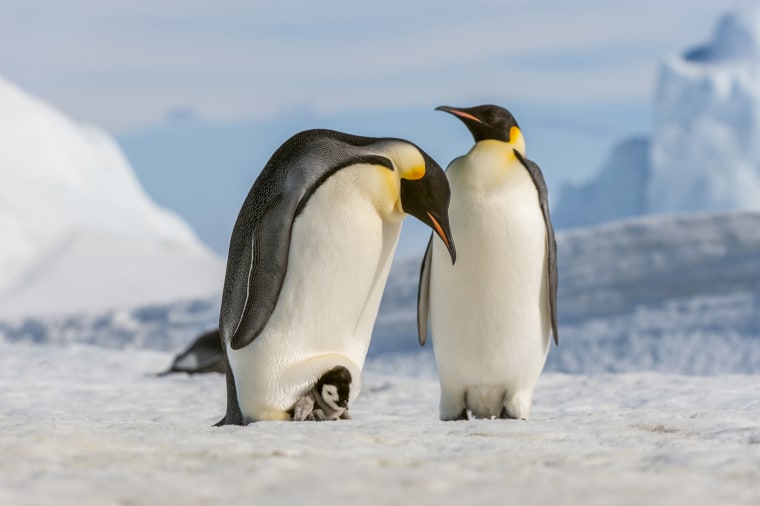All but one of five known breeding sites for emperor penguins in a part of Antarctica experienced a “total breeding failure” during the 2022 season because of the loss of sea ice, according to a study published Thursday.
Using satellite images, scientists at the British Antarctic Survey were able to see that sea ice in the central and eastern Bellingshausen Sea region last year broke up long before the start of the birds’ fledgling period, when penguin chicks would have developed their waterproof feathers.
The research, published Thursday in the journal Communications Earth & Environment, found that more than 90% of emperor penguin colonies in Antarctica could be “quasi-extinct” by the end of the century if global warming continues at its current pace.
“We have never seen emperor penguins fail to breed, at this scale, in a single season,” Peter Fretwell, a geographic information scientist at the British Antarctic Survey and the study’s lead author, said in a statement. “The loss of sea ice in this region during the Antarctic summer made it very unlikely that displaced chicks would survive.”
The findings offer a grim outlook for emperor penguins and their habitats if global warming continues unchecked. The research is also of particular concern because Antarctic sea ice this year has plunged to record lows, far below extents that would be considered typical for this time of year in the Southern Hemisphere.
Emperor penguins tend to return year after year to the same breeding sites, and typically lay their eggs from May to June during winter in Antarctica. Eggs will hatch after 65 days, but it takes until December and January — summer months in the Southern Hemisphere — before chicks grow their waterproof feathers and are able to leave the colonies to find food.
In late 2022, Antarctic sea ice extent tied an all-time low that was set the previous year, said Caroline Holmes, a polar climate scientist at the British Antarctic Survey who was not involved with the penguin study but has used its findings to better understand longer-term trends and anomalies across the southernmost continent.
“We saw a very early break-up of the sea ice and an early melt, particularly in the Bellingshausen Sea region, where we have a lot of the penguin colonies,” she said.
Satellite imagery taken last November showed a total loss of sea ice in the central and eastern Bellingshausen Sea regions. As a result, Fretwell and his colleagues think, there’s a high probability that no penguin chicks survived from four out of the five colonies in that area.
In the study, the scientists wrote that some chicks may have survived on grounded icebergs but added that it’s impossible to make those estimates based only on satellite images.
If the current pace of global warming continues, more than 90% of emperor penguin colonies will be quasi-extinct by the year 2100, the researchers found. “Quasi-extinction” does not mean all emperor penguins will disappear, but rather that the species cannot reproduce adequately to grow the population, and thus may be doomed to extinction even if some birds are still alive.
“We know that emperor penguins are highly vulnerable in a warming climate — and current scientific evidence suggests that extreme sea ice loss events like this will become more frequent and widespread,” Fretwell said in a statement.
Holmes said last year's declines in Antarctic sea ice fit within a broader pattern that has been observed during almost a decade, with the past two years logging the lowest sea ice extents in 45 years of satellite records.
"Particularly in the Bellingshausen Sea, what we saw in November and December 2022 was really unprecedented, in terms of how little sea ice was there and how early that sea ice broke up," she added.
While myriad atmospheric and ocean conditions contribute to variations in how Antarctic sea ice grows and melts each year, climate models suggest that global warming caused by humans is contributing to long-term declines.
But more data is needed to untangle precisely what that means for the stability of Antarctica's continental ice sheets and the health of its ecosystems, Holmes said. Pinpointing those answers is crucial, she added, because sea ice declines this year are even deeper.
Sea ice extent as of this month is roughly 850,000 square miles less than the median value from 1981 to 2022. That missing sea ice is equivalent to an area larger than Greenland, according to the British Antarctic Survey.
Holmes said the study’s findings are yet another alarm bell over the need to limit the impacts of climate change — particularly a because certain amount of warming has already been baked into the system.
“Even if we drop our emissions, there’s going to be a certain amount of ice melt that will still happen,” she said. “But, obviously the more we can limit emissions the better.”

